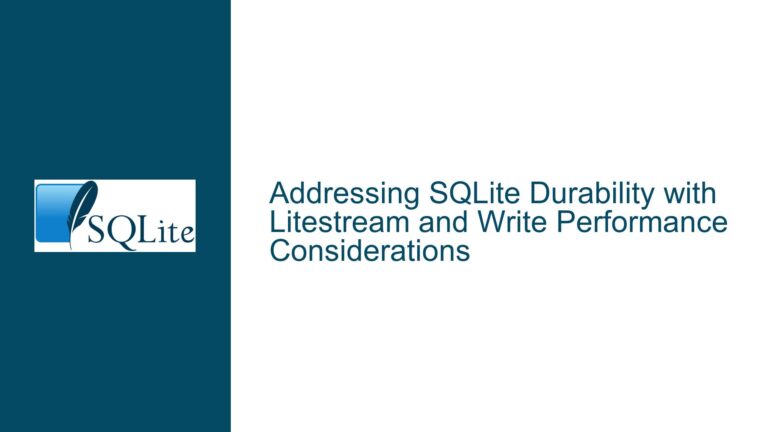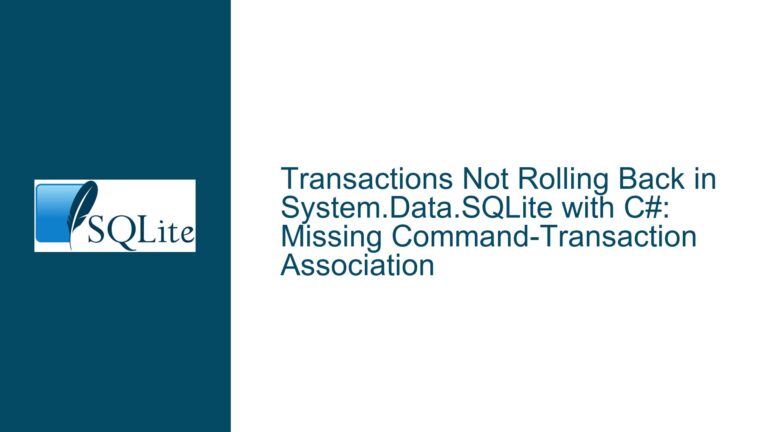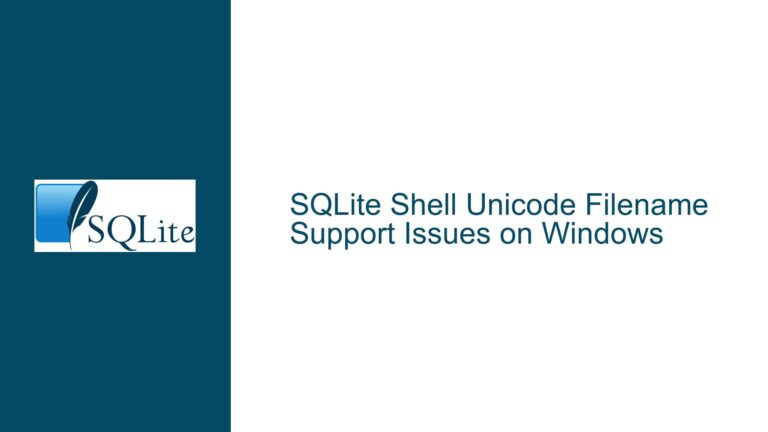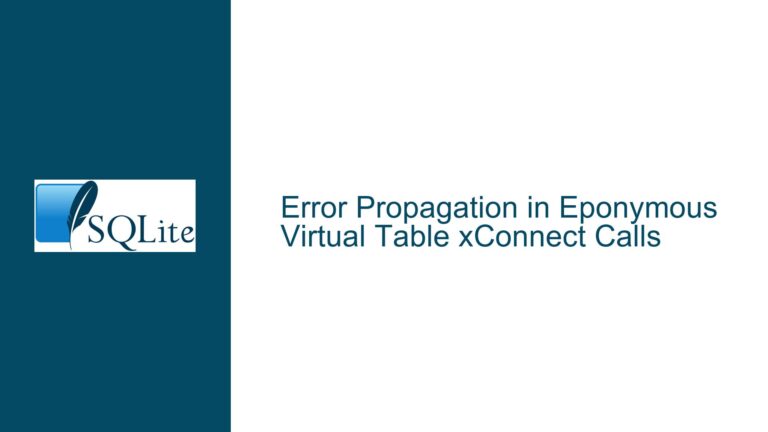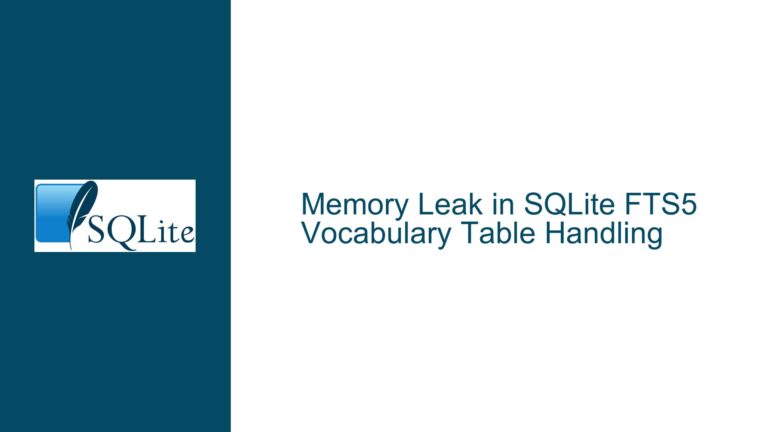Encrypting SQLite Databases in WPF: Connection Errors & Version Conflicts
Encryption Implementation Challenges in WPF with System.Data.SQLite and SQLCipher
1. Encryption Framework Compatibility and Connection Configuration Conflicts
Issue Overview
The core challenge involves implementing database encryption/decryption in a WPF application using SQLite (v3.35.5) with Visual Studio 2019. The developer attempted to use SQLCipher for encryption but encountered critical errors when configuring the connection string with Password=MyPassword or PRAGMA key. The System.Data.SQLite library (v1.0.115.5) rejected these parameters, citing missing encryption support. Subsequent attempts to downgrade to older library versions (e.g., v1.0.112) introduced new errors, including missing SetPassword method references and unresolved NuGet package dependencies. A deeper analysis reveals three interconnected problems:
Encryption Extension Mismatch:
SQLCipher and the legacy System.Data.SQLite encryption module use incompatible cryptographic implementations. SQLCipher employs AES-256 in CBC mode with a key derivation process involving PBKDF2-HMAC-SHA512, while System.Data.SQLite’s older encryption relied on RC4 (deprecated) or AES-128 via Windows CryptoAPI. Attempting to open a SQLCipher-encrypted database with System.Data.SQLite’sPasswordparameter will fail due to header format differences.Library Version Fragmentation:
System.Data.SQLite removed built-in encryption support after v1.0.112 due to licensing conflicts with upstream SQLite changes. Newer versions (≥1.0.115) lack theSQLiteConnection.SetPassword()method andPasswordconnection string property, forcing developers to either downgrade or use third-party forks. However, NuGet no longer hosts pre-v1.0.115 packages, requiring manual DLL integration, which introduces runtime errors if dependencies likeSQLite.Interop.dllare misconfigured.Toolchain Limitations:
Visual Studio’s design-time tools (e.g., Entity Framework scaffolding) and DB Browser for SQLite cannot natively handle SQLCipher-encrypted databases without custom builds. This creates friction during development, as encrypted databases remain inaccessible in standard tools, necessitating workarounds like temporary decryption or custom viewers.
Root Causes
The errors stem from three primary sources:
Unsupported Encryption Workflow:
UsingPassword=MyPasswordin the connection string assumes the presence of System.Data.SQLite’s legacy encryption module, which was removed in newer versions. Conversely, SQLCipher requires invokingPRAGMA keyafter opening the connection, not via the connection string. This mismatch triggers "library not built with encryption support" errors.Incorrect Library Binding:
Projects referencing System.Data.SQLite via NuGet automatically pull the latest version, which lacks encryption support. Manually referencing v1.0.112 DLLs without ensuring architecture consistency (x86/x64) or includingSQLite.Interop.dllin the output directory leads to "SQL logic error" or "invalid reference" exceptions. Additionally, .NET 5.0’s runtime compatibility layer may block legacy CryptoAPI calls used by older encryption modules.Path Resolution Failures:
Relative paths in connection strings sometimes resolve to unexpected directories (e.g.,bin\Debug\net5.0instead of the project root), causing "no such table" errors if the database isn’t copied to the output folder. This is exacerbated when encryption obscures the database header, preventing SQLite from auto-creating missing tables.
Resolution Strategies and Technical Workarounds
Step 1: Select a Supported Encryption Model
Choose between two encryption frameworks based on project constraints:
SQLCipher (Open-Source, Cross-Platform):
- Pros: AES-256, HMAC verification, and PBKDF2 key derivation. Compatible with community tools like DB Browser for SQLCipher.
- Cons: Requires P/Invoke or a commercial .NET adapter (e.g., Zetetic’s SQLCipher for ADO.NET).
Legacy System.Data.SQLite Encryption (Windows-Only):
- Pros: Integrated into System.Data.SQLite v1.0.112. No external dependencies.
- Cons: Deprecated algorithms (RC4/AES-128). Incompatible with SQLCipher-encrypted databases.
Step 2: Configure System.Data.SQLite v1.0.112 for Legacy Encryption
For projects requiring Windows-only encryption:
Download DLLs Manually:
Obtain v1.0.112 binaries from system.data.sqlite.org. Usesqlite-netFx46-binary-Win32-2015-1.0.112.0.zipfor 32-bit orsqlite-netFx46-binary-x64-2015-1.0.112.0.zipfor 64-bit.Add References Correctly:
- Reference
System.Data.SQLite.dlldirectly in the project. - Copy
SQLite.Interop.dllto\bin\x86\or\bin\x64\based on architecture. - Do not reference
SQLite.Interop.dllvia Visual Studio’s "Add Reference" dialog.
- Reference
Initialize Encryption:
using (var conn = new SQLiteConnection("Data Source=MyDatabase.db;")) { conn.Open(); conn.SetPassword("MyPassword"); // Encrypts an unencrypted database conn.ChangePassword("NewPassword"); // Updates password }Handle Relative Paths:
Ensure the database file is copied to the output directory by settingCopy to Output DirectorytoCopy alwaysin file properties. Use|DataDirectory|macro for dynamic path resolution:string connectionString = "Data Source=|DataDirectory|\\MyDatabase.db;Password=MyPassword;";
Step 3: Integrate SQLCipher via P/Invoke or Commercial Libraries
For cross-platform or stronger encryption:
Use Zetetic’s Commercial ADO.NET Library:
Purchase SQLCipher for ADO.NET from Zetetic, which provides aSQLiteConnectionclass with native SQLCipher support.Manual P/Invoke Configuration:
- Link against
sqlcipher.dll(Windows) orlibsqlcipher.so(Linux/macOS). - Execute
PRAGMA keyafter opening the connection:using (var conn = new SQLiteConnection("Data Source=MyDatabase.db;")) { conn.Open(); using (var cmd = new SQLiteCommand("PRAGMA key = 'MyPassword';", conn)) { cmd.ExecuteNonQuery(); } // Execute queries } - Critical: Compile SQLCipher with
-DSQLITE_HAS_CODECand link against OpenSSL or other crypto providers.
- Link against
Step 4: Mitigate Development Tool Limitations
- DB Browser for SQLCipher: Use the SQLCipher-compatible fork to inspect encrypted databases during development.
- Temporary Decryption Scripts: Create a helper utility to decrypt databases for debugging:
# Using SQLCipher’s command-line tool sqlcipher MyDatabase.db > PRAGMA key = 'MyPassword'; > ATTACH DATABASE 'decrypted.db' AS plaintext KEY ''; > SELECT sqlcipher_export('plaintext'); > DETACH DATABASE plaintext;
Step 5: Address Common Compilation and Runtime Errors
"Password property not supported":
Ensure System.Data.SQLite v1.0.112 is referenced, not newer versions. Check NuGet for accidental upgrades."SQL logic error: no such table":
Verify the database path resolves correctly. Use absolute paths during testing. Enable foreign key constraints withPRAGMA foreign_keys = 1;."Unable to load DLL ‘SQLite.Interop.dll’":
PlaceSQLite.Interop.dllin\bin\x86\or\bin\x64\subfolders matching the project’s build architecture."SetPassword method missing":
Reinstall System.Data.SQLite v1.0.112 manually. NuGet packages for this version are deprecated and may reference incompatible forks.
Final Recommendations
For new projects, prefer SQLCipher with Zetetic’s commercial library to avoid compilation complexity. Legacy System.Data.SQLite encryption suffices for internal Windows tools but poses security risks due to outdated crypto. Always validate encryption by inspecting database headers with a hex editor; encrypted databases should start with a non-standard SQLite header (e.g., 0x534Q4C69 for SQLCipher).

